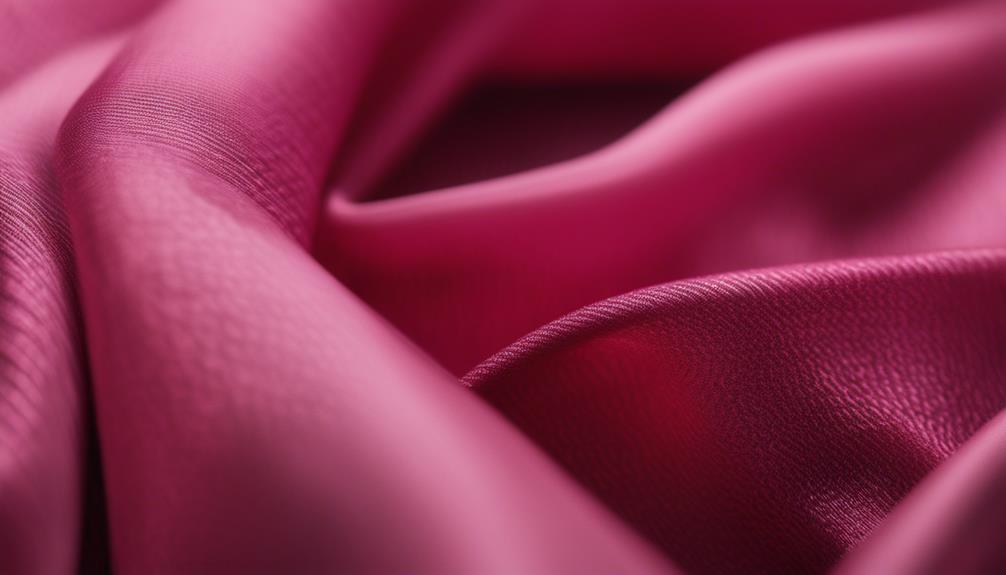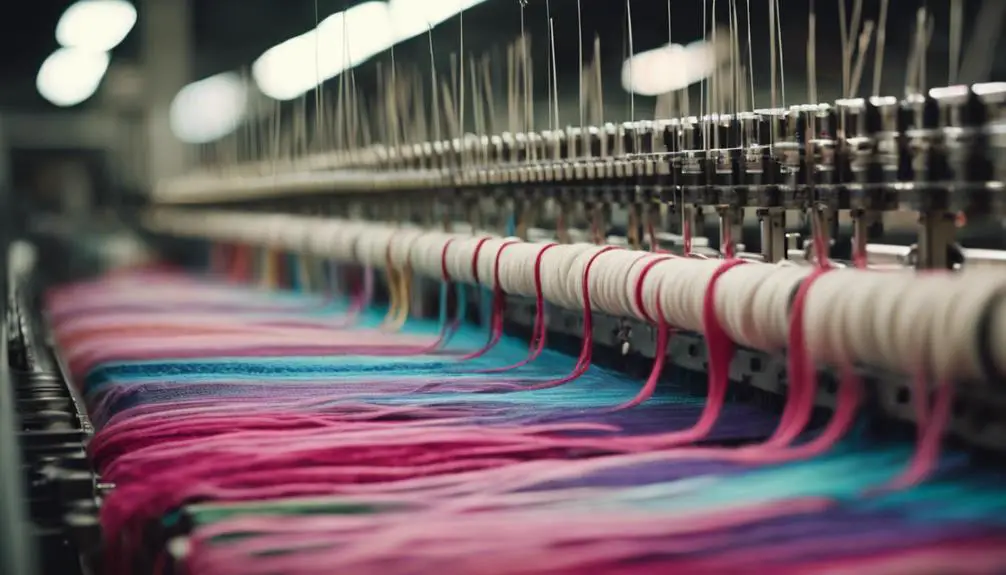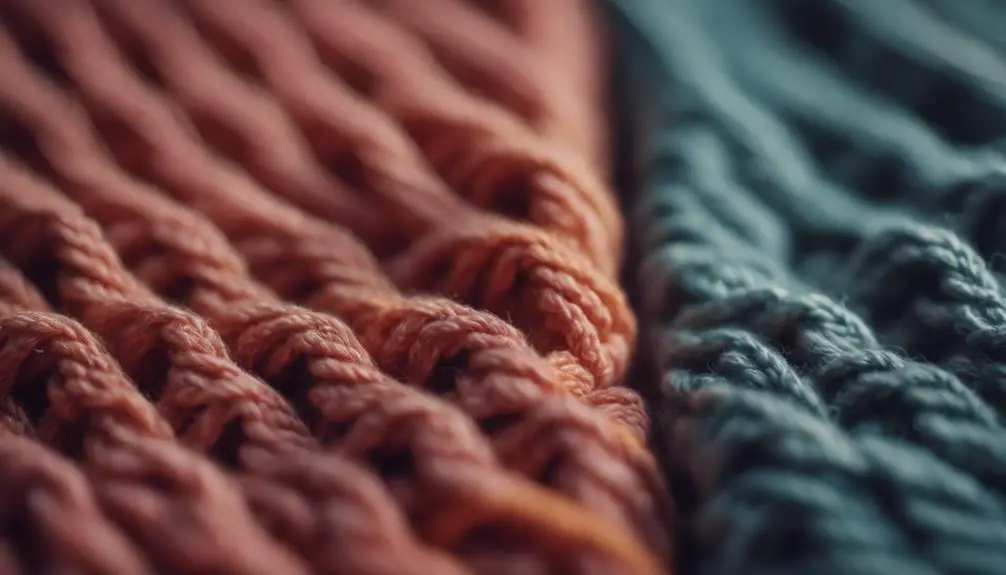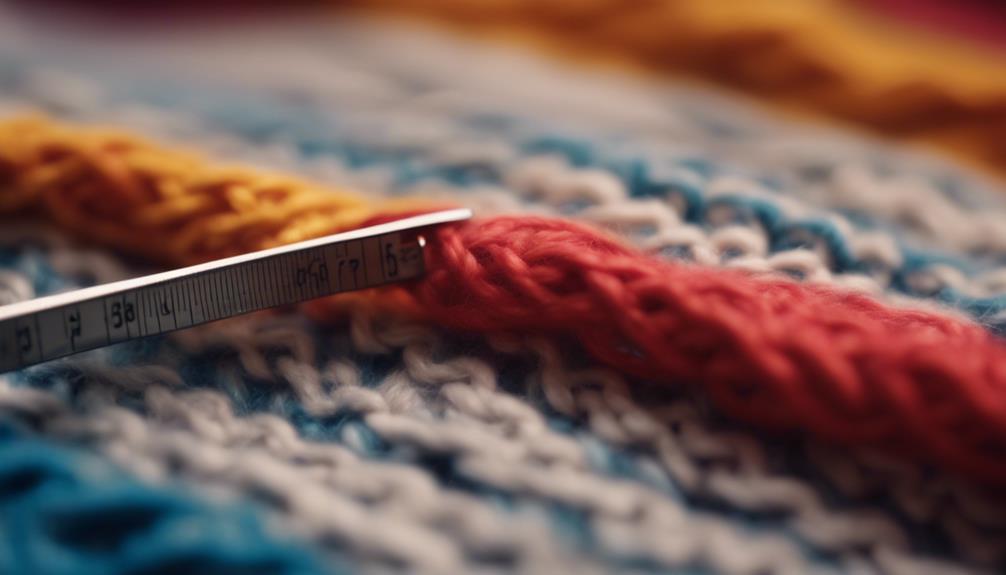To identify tricot fabric, look for its unique zigzag weave and fine lengthwise ribs on the front, with a textured surface on the back. This warp-knit material typically features synthetic fibers like nylon or polyester. You'll notice its remarkable stretch; it flexes both lengthwise and widthwise while retaining shape. Tricot is smooth to the touch, making it great for lingerie and activewear. Unlike weft knitting, it has different surfaces on each side. If you pay attention to these details, you'll become adept at distinguishing tricot from other fabrics and uncover other useful tips along the way.
Definition of Tricot Fabric

Tricot fabric is a distinctive type of warp-knit material known for its unique zigzag weave, which creates a smooth surface on the front and a textured feel on the back. This fabric is primarily made from synthetic fibers like nylon and polyester, which lend it durability and elasticity. When you examine tricot fabric closely, you'll notice its fine lengthwise ribs on the front and horizontal ribs on the back. This close-knit structure not only adds visual interest but also enhances the fabric's stability and resistance to unraveling.
One of the standout features of tricot fabric is its excellent stretch properties. This means it can stretch while maintaining its shape, making it a popular choice for activewear and other garments that require flexibility and comfort. Originally derived from the French verb "tricoter," meaning to knit, tricot fabric strikes a balance between softness and sturdiness. Whether you're looking for lingerie, swimwear, or athletic wear, understanding the definition of tricot fabric helps you appreciate its versatility and suitability for various applications. With its unique characteristics, tricot fabric is a reliable option in the world of textiles.
Characteristics of Tricot
When exploring the features of tricot fabric, you'll quickly notice its distinctive characteristics that set it apart from other textiles. Here are some key traits that define tricot fabrics:
- Unique Weave: Tricot features a zigzag weave with fine lengthwise ribs on the front and textured horizontal ribs on the back, creating a visually interesting surface pattern.
- Smooth Texture: The fabric boasts a soft and comfortable smooth texture, making it an excellent choice for lingerie and sleepwear.
- Excellent Stretchability: Known for its remarkable elasticity both lengthwise and widthwise, tricot is perfect for activewear and close-fitting garments, allowing for freedom of movement.
- Durable Structure: Produced using warp knitting techniques, tricot fabrics have a tightly-knit structure that resists snagging and unraveling, enhancing their durability.
These characteristics make tricot not only visually appealing but also practical for various clothing applications. Whether you're looking for fabric that conforms beautifully to body shapes or one that maintains structural integrity, tricot delivers on all fronts.
Manufacturing Process

The manufacturing process of tricot fabric involves a precise warp knitting technique that creates its unique structure. You'll find that tricot is produced on flatbed knitting machines, where multiple yarns are fed into the machine simultaneously. This knitting method forms loops that interlock, resulting in a zigzag pattern essential to tricot's design.
Each needle in the machine loops its own thread, creating parallel rows of fabric. The front side is smooth, while the back features a textured surface, adding to the fabric's visual interest and feel. After the knitting process is complete, the finished tricot fabric is rolled onto a cylinder for easy handling.
Sometimes, additional finishing processes like dyeing or printing are applied to enhance the fabric's appearance. This manufacturing technique not only gives tricot its distinct look but also contributes to its durability. Thanks to its excellent wrinkle and run resistance, tricot is particularly well-suited for activewear. Understanding this process helps you appreciate the craftsmanship behind the fabric, making it easier to identify tricot in various applications.
Common Applications
Utilizing tricot fabric in various applications showcases its remarkable versatility and performance. You'll find tricot is commonly used across a wide range of garments and textiles due to its unique properties. Here are some key applications:
- Swimwear: Tricot's excellent stretchability and moisture-wicking properties make it ideal for swimwear, providing comfort and performance during water activities.
- Lingerie and Underwear: The fabric's smooth texture enhances comfort against the skin, making it a popular choice for lingerie while maintaining durability.
- Activewear: Its sturdy construction supports athletic apparel needs, such as yoga pants and sports bras, allowing for freedom of movement and resilience.
- Lining Material: Tricot is often used as a lining material in jackets and dresses, offering added comfort and structure without adding bulk.
Beyond clothing, tricot also finds its place in home textiles. From bed linens to curtains, it delivers a soft feel and durability that enhances everyday living. With its diverse applications, tricot remains a valuable choice in the world of fabrics, proving its worth in both fashion and function.
Distinguishing Tricot and Weft Knitting

Understanding the differences between tricot and weft knitting can greatly enhance your fabric selection process. Tricot is formed using multiple yarns that create simultaneous loop formations, which results in a unique texture. You'll notice fine ribs running perpendicular on one side and a smooth surface on the other. In contrast, weft knitting typically uses a single or multiple yarns to create loops side-to-side, resulting in the same texture on both sides.
When examining their structures, you'll find that tricot's design doesn't allow for easy disassembly in reverse, unlike weft knitting, which can be unraveled in the opposite direction. Additionally, tricot fabric made from varieties like warp satin and velvet exhibits stretch primarily in the warp direction, while weft knitting stretches in both the lengthwise and widthwise directions.
If you're looking for complex patterns, tricot often provides more intricate designs compared to the simpler styles found in weft knitting, such as single jersey and double interlock. By recognizing these key differences, you can make more informed choices when selecting fabrics for your projects.
Advantages of Tricot
Tricot fabric stands out for its remarkable durability and versatility, making it an excellent choice for a wide range of garments. You'll appreciate that tricots have a sturdy construction, ensuring they withstand daily wear and tear. Their unique design also prevents billowing or sagging, helping your clothes maintain their shape.
Here are some advantages of choosing tricot:
- Durability: Tricot's sturdy nature makes it a popular choice for lining materials, ensuring your garments last longer.
- Versatility: Available in diverse fiber compositions, tricot suits various applications, from activewear to casual clothing.
- Comfort: The fabric's construction allows for breathability and comfort, making it ideal for both everyday wear and athletic use.
- Customizability: With options for custom printing, tricot can showcase unique designs, perfect for personalized garments.
Types of Tricot Structures

When exploring the various types of tricot structures, you'll find that each one serves a distinct purpose and offers unique qualities suited for different applications. The plain tricot is the most basic structure, featuring a smooth surface that's perfect for lightweight apparel and provides good stretch in the lengthwise direction. In contrast, raschel tricot combines stitches with cords or laces, creating a textured fabric ideal for fashion pieces and upholstery.
If you're looking for warmth, brushed tricot has a soft, suede-like finish, making it perfect for cold-weather clothing and cozy blankets. For activewear, mesh tricot is characterized by its open and breathable structure, widely used in sportswear and athletic jerseys for better ventilation. Finally, power mesh is a high-elasticity fabric that mainly stretches in one direction. It's popular for shapewear and lingerie, offering excellent support and comfort.
These tricot structures emerge from different knitting processes, and the fabrics can range from lightweight to heavy, allowing for a variety of uses, including being used as a lining in garments. Understanding these types can help you choose the right fabric for your needs.
Frequently Asked Questions
How Do I Identify Tricot Fabric?
To identify tricot fabric, you'll want to feel its smooth front and textured back. Notice its zigzag pattern and remarkable stretch. Check for lightweight, breathable qualities, and guarantee it's durable against snagging and unraveling.
What Does Tricot Look Like?
Tricot looks smooth on the front with fine lengthwise ribs and a textured back featuring horizontal ribs. Its unique zigzag pattern and soft yet sturdy feel make it perfect for activewear and lingerie applications.
What Are the Characteristics of Tricot Fabric?
Tricot fabric's characteristics include its unique zigzag weave, excellent stretchability, and moisture-wicking properties. You'll appreciate its durable, lightweight feel and versatility for activewear or lingerie, making it a fantastic choice for various applications.
What Does Tricot Fabric Feel Like?
Tricot fabric feels smooth and soft against your skin, providing comfort during wear. Its lightweight yet sturdy nature guarantees it maintains shape, while the ribbed back adds stretchability, making it ideal for activewear and lingerie.





Can you be more specific about the content of your article? After reading it, I still have some doubts. Hope you can help me.
Your point of view caught my eye and was very interesting. Thanks. I have a question for you.